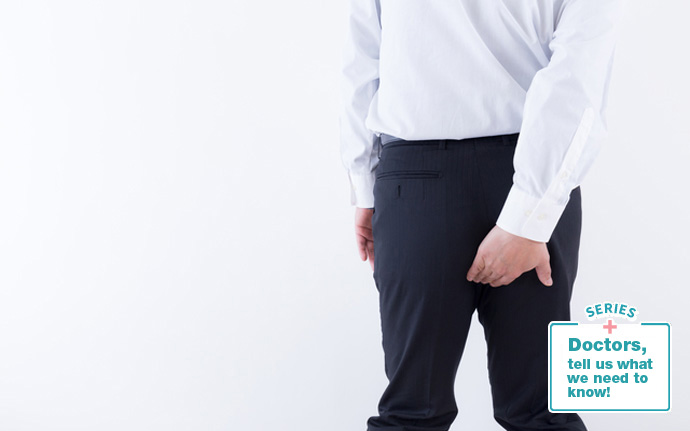
Patients who visit a clinic or hospital presenting with anal bleeding and pain are often suffering from any of the following three major diseases: "hemorrhoids (piles)," "anal fissure," and "anal fistula." There are however a number of other possible diseases such as "perianal dermatitis" and "pudendal neuralgia." With regard to "pudendal neuralgia" in particular, persistent pain may continue. There are some patients suffering from persistent pain even after surgery and treatment for "hemorrhoids (piles)." In such patients, a surgical procedure might have increased "pudendal neuralgia." Since postoperative pain may exacerbate neuralgia, appropriate treatment must be determined after careful consideration.

The major cause of hemorrhoids is pressure on the anal region. Constipation, diarrhea, and sedentary work may also cause hemorrhoids. For example, there is a case in which a patient with prolapsed hemorrhoids in his/her 40s, who had been manually pushing hemorrhoids back in place, stopped experiencing prolapsed hemorrhoids after retirement. Hemorrhoids might have not become swollen because there was no pressure on the anal region after retirement. Surgical procedures may be unnecessary for hemorrhoids, and such hemorrhoids can be adequately cured by drug therapy. Hemorrhoids can be prevented not only by improvement of bowel movements, but also by elimination of possible causes.

"Hemorrhoids (piles)" are caused by bowel circumstances, such as constipation. Due to constant straining, the supporting tissue in the anal canal becomes loose and so-called cushions (anal cushions), masses of vascular and connective tissue structures, become larger and protruded. "Anal fissure" is a tear often caused by hard stools due to constipation, but it may also occur in persons with diarrhea. "Anal fistula" is likely to occur in persons with a physical constitution prone to diarrhea. This is because the diarrheal stools enter a small cavity at the border between the anus and rectum, causing suppuration. In any case, pressure on the anal region is the main cause.
Other than this, bowel diseases may cause anal disorders. Intestinal inflammation, such as Crohn's disease, may cause anal fissure or anal fistula.
The physical constitution of the patient seems to be related to a susceptibility to hemorrhoids. Children whose parents have a history of hemorrhoids develop hemorrhoids, cases of which are relatively common. Children and parents may have similar shaped buttocks as with other features. In addition to having similar constitutions, eating and bowel habits may be similar.

Anal fistula is caused by bacterial entry into a small hole between the rectum and the anus. It is predominantly seen in male patients. There are some opinions that men are more likely to have bacteria in the hole because they have higher anal sphincter pressures and also that male hormones are related to anal fistula. The reason is unknown, but actually there are many male patients with anal fistula.
Moreover, it has been pointed out that overweight people tend to be more likely to suffer from "anal fistula." Overweight people may be susceptible to infections due to diabetes mellitus and other conditions, and consequently, many overweight people may be suffering from anal fistula. Anal fistula is often caused by diarrhea, and there are many patients who experience swelling of the anus after drinking too much alcohol. Of course, there are female patients with anal fistula. It is known that women are more likely to have anal fistula in the front (genital side) than men.

Hemorrhoids (piles) are common among patients with constipation, but it has been pointed out that hemorrhoids are not caused by constipation itself but by prolonged sitting on the toilet due to constipation. Anal fissure is caused by various factors, such as constipation and diarrhea. It has been reported that sustained contraction (spasming) of the anal sphincter muscle is one of the causes of anal fissure. A tear in the skin often occurs on the posterior side of the anal canal because blood flow is least around the posterior side. With regard to anal fistula and anal abscess, there are about 12 to 15 holes (anal sacs) from which "rectal mucus" is secreted and which are located 2 cm inside the anus. If contaminants or bacteria enter the hole, inflammation may occur. Diarrhea is considered to be the main cause. "Anal abscess," a condition in which pus accumulates in the perianal region, is alleviated by incision and removal of pus. However, if the inner opening from which rectal mucus is secreted and a fistula tract for pus drainage to the outside remain, this may lead to the clinical condition of anal fistula.
